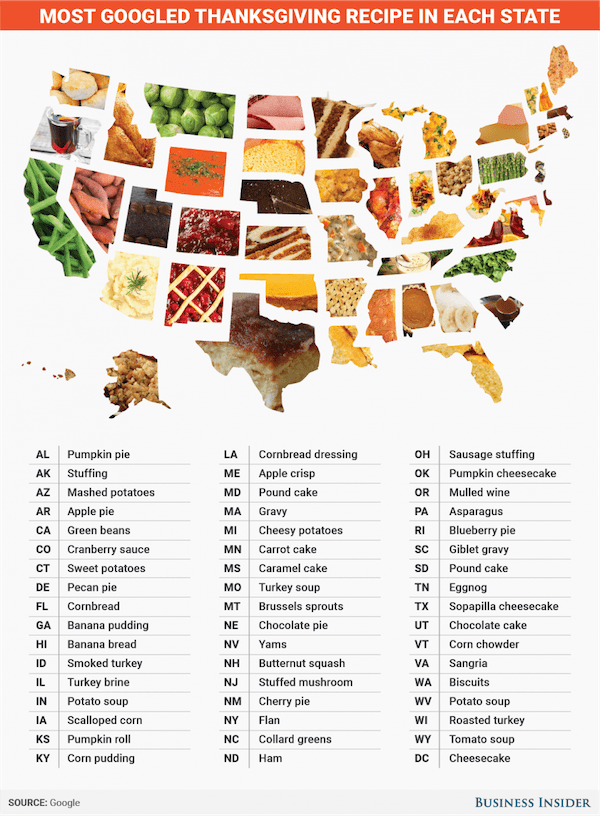
Thanksgiving is probably going to look different for a lot of folks this year, for the obvious reasons. One thing that probably won’t change for a lot of families in America is the menu. Some people are planning to scale things back to serve fewer people this year but most I’ve talked to are dead set on keeping with their longstanding traditions, even if they’re doing everything over Zoom. I know for some families, the same dishes have been made every single Thanksgiving going back decades, with no substitutions or deviations allowed! The recipes may vary, but every year Americans make ver similar meals. Below is a little history behind six classic Thanksgiving foods.
Turkey: Alexander Hamilton himself once remarked that “No citizen of the U.S. shall refrain from turkey on Thanksgiving Day,” and many Americans agree! I know some families go for ham but it’s the humble turkey that is almost a universally recognized symbol of our Thanksgiving tradition. The two have been together since the beginning when the Pilgrims and Wampanoag tribe of Native Americans had that famous meal back in 1621. Of course, there is no way to really confirm that a turkey was served but there is evidence that supports it. One first-person account of the year’s harvest from governor William Bradford references “a great store of wild turkeys,” and another first-person account, from colonist Edward Winslow, confirms that the settlers “killed as much fowl as … served the company almost a week.” Some historians think duck or goose was more likely the poultry option. However it started, turkey became the main course over the years for a very simple reason – it was practical. English settlers were accustomed to eating fowl on holidays, but for early Americans, chickens were more valued for their eggs than their meat, and rooster was tough and unappetizing. Meanwhile, turkeys were easy to keep, big enough to feed a whole family, and cheaper than ducks or geese.
Stuffing/Dressing: Stuffing is the most common side dish served at Thanksgiving every year. It would have been a familiar concept to those early settlers as well, although their version was likely quite different from what we’re used to. The first colonists didn’t have access to traditional flour so bread stuffing was not on the menu. Instead, they likely used a mixture of chestnuts, herbs, and chunks of onion to flavor the birds. It’s highly probably they stuffed some oysters in there as well, a tradition that dates back centuries. At one time, oysters were plentiful and cooks filled turkeys and other birds with them to stretch the pricier fowl. Over the years, our versions of stuffing and dressing have evolved into a full blown dish rather than just a flavor step.
Mashed Potatoes: The pilgrims were not lucky enough to be feasting on mashed potatoes as we know them today as potatoes weren’t even available in 17th century New England. The tale of how they ended up as a side dish on nearly every Thanksgiving table actually traces back to the days of Abraham Lincoln, who first declared the last Thursday in November as a national holiday. Allegedly, he made the move under pressure from Sarah Josepha Hale, a prolific novelist, poet, and editor who had waged a 36-year campaign to make it a national holiday, believing it would be a moral benefit for families and communities. In her position as the editor for several women’s magazines, she frequently wrote about the holiday, including recipes and descriptions of idealized Thanksgiving meals, which often featured mashed potatoes.
Sweet Potatoes: Also not likely on the original Thanksgiving menu, the tradition of sweet potatoes actually came from African-American culture of the American south. The tubers grew well in the south and became a staple for many enslaved plantation workers, who used them as a substitute for the yams that were found in their homeland. Sweet potato pie was one of the dishes Sarah Josepha Hale heralded for the ideal meal, too. Some today won’t eat sweet potatoes without a topping of gooey marshmallow, which wasn’t actually invented until the turn of the century. In 1917, the Angelus Marshmallows company distributed a recipe booklet that taught Americans how they might use marshmallows, including the first-known recipe for mashed sweet potatoes with marshmallow topping.
Cranberry Sauce: Cranberries would have been widely available to the early colonists but the most certainly did not have sugar. American Indians had long cultivated the berries, one of the few fruits that actually originated in North America – along with Concord grapes, blueberries, and pawpaws. Colonists would have incorporated them into other dishes, such as pemmican, which mixed mashed cranberries with lard and dried venison. By the Civil War, they were such a holiday staple that General Ulysses S. Grant famously demanded his soldiers be provided cranberries for their Thanksgiving Day meal.
Pumpkin Pie: Like cranberries, pumpkin pie does have ties to the original Thanksgiving. The colonists would not have had a pie in the traditional sense though, as they couldn’t have replicated wheat flour. According to “Eating in America: A History”, Native Americans used pumpkin as a dessert meal: “Both squash and pumpkin were baked, usually by being placed whole in the ashes or embers of a dying fire and they were moistened afterwards with some form of animal fat, or maple syrup, or honey.” It’s likely that Hale was inspired by those stories when pumpkin pie appeared in her culinary descriptions.







